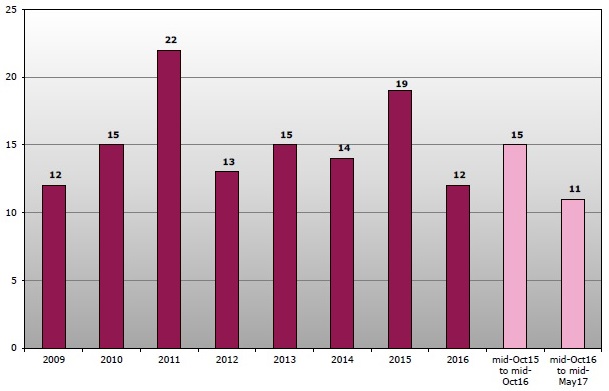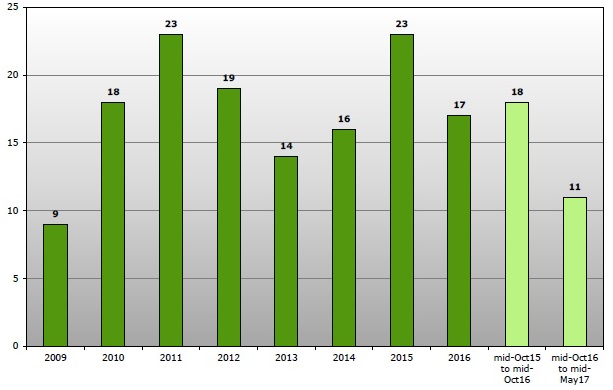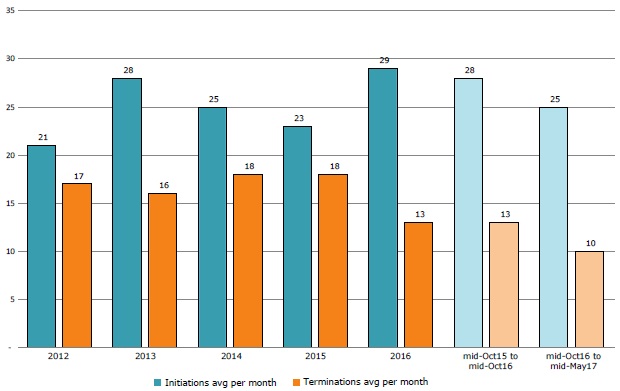News
WTO members record lowest monthly average in new trade restrictions since 2008

Between mid-October 2016 and mid-May 2017 WTO members recorded the lowest monthly average of new trade restrictions since the financial crisis of 2008, according to the Director-General’s mid-year report on trade-related developments presented to members on 24 July.
Director-General Roberto Azevêdo welcomed this news, and urged WTO members to show continued moderation. The report also shows that the trade coverage of the trade-facilitating measures was significantly higher than that of the restrictions.
The report calls on members to continue improving the global trading environment, including by implementing the WTO Trade Facilitation Agreement which entered into force in February this year, and working together to achieve a successful outcome at the 11th WTO Ministerial Conference in December.
The report, which was discussed at the 24 July meeting of the WTO’s Trade Policy Review Body (TPRB), shows that 74 new trade-restrictive measures were initiated by members during the review period, including new or increased tariffs, customs regulations and quantitative restrictions, amounting to almost 11 new measures per month. This constitutes a significant decrease over the previous review period (mid-October 2015 to mid-May 2016), where an average of 15 measures per month were recorded, and marks the lowest monthly average over the past decade.
During the same period, WTO members applied 80 new measures (over 11 new measures per month) aimed at facilitating trade, including eliminating or reducing tariffs and simplifying customs procedures. This marks the second lowest monthly average since the trade monitoring exercise began in 2008.
The trade coverage of import-facilitating measures (US$ 183 billion) was more than three times the estimated trade coverage of import-restrictive measures (US$ 49 billion) and more than six times higher than the coverage estimated for trade remedy initiations (US$ 27 billion). In addition, liberalization associated with the 2015 expansion of the WTO’s Information Technology Agreement (ITA) continued to feature as an important contributor to trade facilitation.
“The report shows an encouraging decrease in the rate of new trade-restrictive measures put in place – hitting the lowest monthly average since the financial crisis,” Director-General Roberto Azevêdo said. “The larger trade coverage of import-facilitating measures during the review period is also a very positive development and a clear sign that WTO members are working to improve the global trading environment. I urge WTO members to continue showing moderation and restraint in their use of trade restrictions, despite the persistent uncertainty facing the global economy.”
Key findings
-
WTO members implemented 74 new trade-restrictive measures during the review period (mid-October 2016 to mid‑May 2017), including new or increased tariffs, customs regulations and quantitative restrictions, amounting to almost 11 new measures per month. This represents a significant decrease over the previous period and marks the lowest monthly average since 2008.
-
WTO members applied 80 measures aimed at facilitating trade over this review period, including eliminated or reduced tariffs and simplified customs procedures. This equates to an average of over 11 new measures per month which is the second-lowest monthly average since trade monitoring began in 2008.
-
During the review period, the estimated trade coverage for trade-facilitating import measures (US$ 183 billion) significantly exceeded the estimated trade coverage of trade‑restrictive import measures (US$ 49 billion).
-
This Report highlights that initiations of trade remedy investigations represented 44% of the total number of trade measures taken during the review period; although the amount of trade covered is relatively small (US$ 27 billion for trade remedy initiations and US$ 6 billion for terminations).
-
Transparency and predictability in trade policy remains vital for all actors in the global economy. WTO members must show leadership in reiterating their commitment to open and mutually beneficial trade as a key driver of economic growth and a major engine for prosperity.
-
Faced with continuing global economic uncertainties, WTO members should seek to continue improving the global trading environment, including by implementing the WTO Trade Facilitation Agreement, which entered into force in February this year, and working together to achieve a successful outcome at the 11th WTO Ministerial Conference in December.
Trade-restrictive measures
(average per month)

Note: Values are rounded. Changes to averages of previous years reflect continuing updates of the TMDB.
Source: WTO Secretariat.
Trade-facilitating measures
(average per month)

Note: Values are rounded. Changes to averages of previous years reflect continuing updates of the TMDB.
Source: WTO Secretariat.
Trade remedy trends – initiations and terminations
(average per month)

Note: Values are rounded.
Source: WTO Secretariat.
Overview of trade measures, mid-October 2016 to mid-May 2017
(by number)

Source: WTO Secretariat.
Trade coverage of import measures, mid-October 2016 to mid-May 2017
(US$ billion)

Note: ITA expansion measures are not included.
Source: WTO Secretariat.




